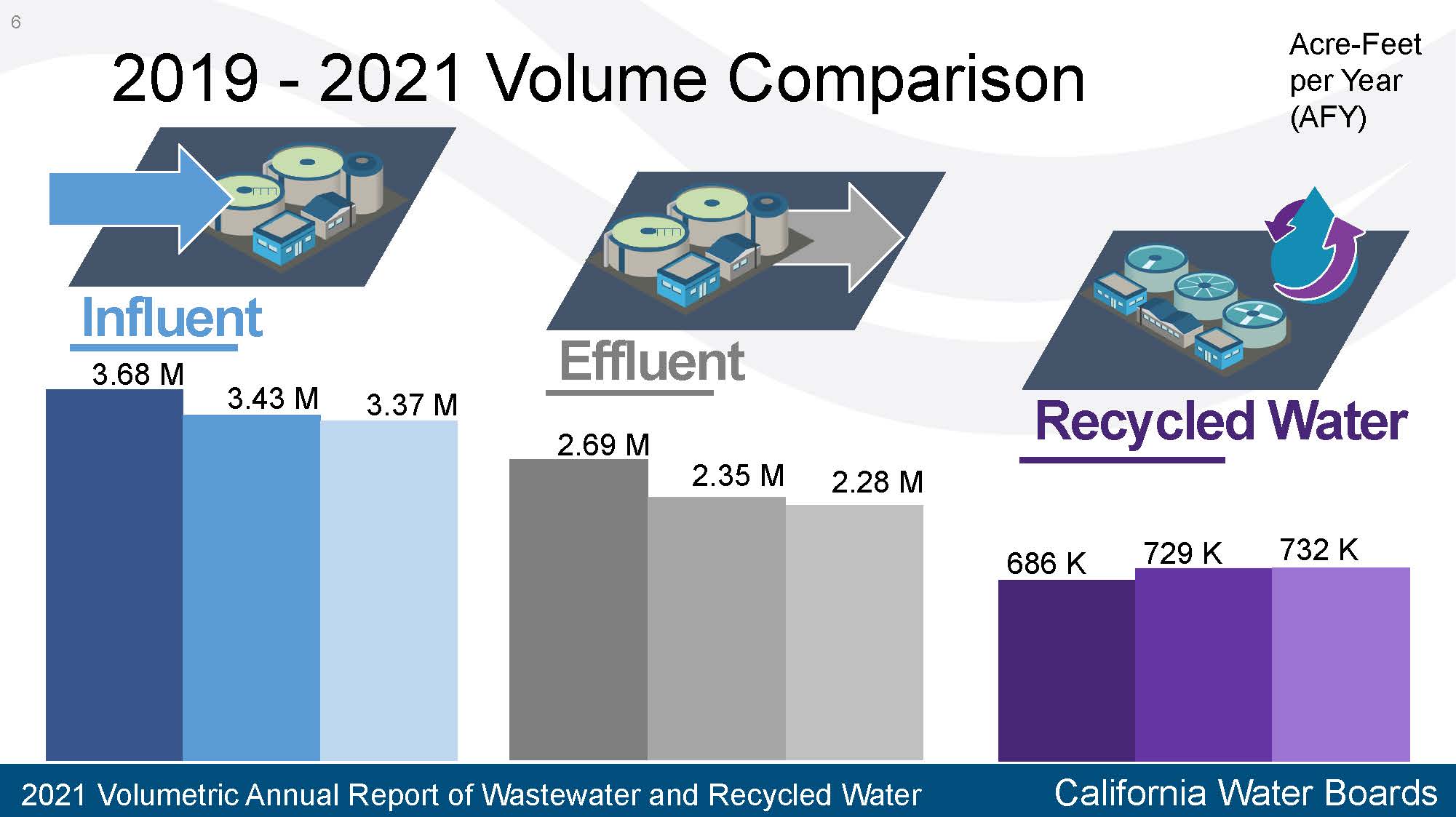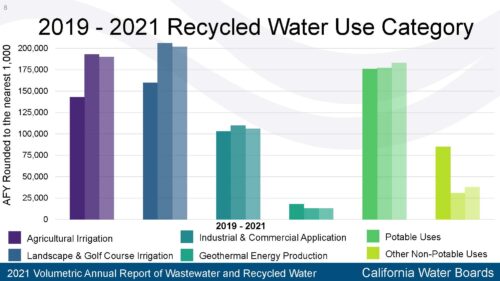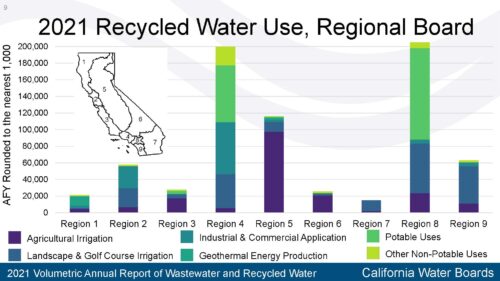At the August 2 meeting of the State Water Board, Rebecca Greenwood, Engineering Geologist with the Recycled and Desalination unit of the Division of Water Quality, reported on the data submitted by wastewater and recycled water facilities for 2021.
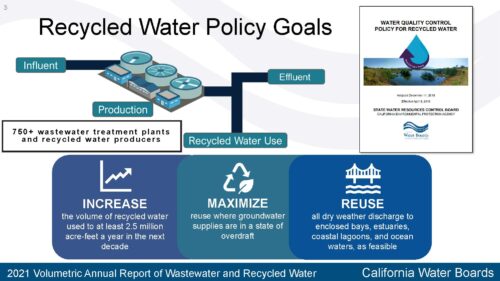 California has a long history of water recycling and reuse, with data collected intermittently since the 1970s. The Volumetric Annual Report was developed and implemented in 2019 to keep track of the numeric and narrative goals set in the Board’s recycled water policy. Now, the Board consistently collects annual information on volume data from over 750 wastewater treatment plants and recycled water producers.
California has a long history of water recycling and reuse, with data collected intermittently since the 1970s. The Volumetric Annual Report was developed and implemented in 2019 to keep track of the numeric and narrative goals set in the Board’s recycled water policy. Now, the Board consistently collects annual information on volume data from over 750 wastewater treatment plants and recycled water producers.
The recycled water goals focus on increasing the volume of recycled water used statewide, increasing the reuse of wastewater that is now discharged into the ocean, and increasing reuse in areas where groundwater supplies are threatened.
The goals set in the recycled water policy are also included in the state’s Water Resilience Portfolio and were originally based on the goals set in water code section 13577. Ms. Greenwood noted that these goals focus specifically on California Code of Regulations Title 22 treatment and use of recycled water and do not particularly address the other beneficial uses of wastewater, such as maintaining streamflow to support instream beneficial uses.
Compliance
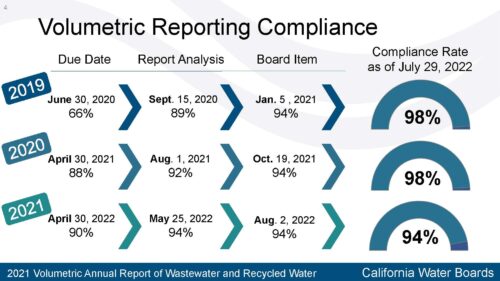 The Board ensures compliance with the reporting through extensive outreach and education efforts that begin with emails and phone calls reminding folks of the upcoming deadline. Post-deadline includes more specific assistance to each facility and discussions with the Office of Enforcement for issuing notices of violations for any facilities not in non-compliance. The last phase is corrections and cleanup, where staff reviews the initial analysis and determines if any corrections or anomalies need to be addressed within the data set. Then, additional specific outreach is made to those facilities, if necessary.
The Board ensures compliance with the reporting through extensive outreach and education efforts that begin with emails and phone calls reminding folks of the upcoming deadline. Post-deadline includes more specific assistance to each facility and discussions with the Office of Enforcement for issuing notices of violations for any facilities not in non-compliance. The last phase is corrections and cleanup, where staff reviews the initial analysis and determines if any corrections or anomalies need to be addressed within the data set. Then, additional specific outreach is made to those facilities, if necessary.
“We’re getting more efficient every year and achieving a solid compliance rate by the board item date,” said Ms. Greenwood, noting that the compliance rate for 2021 is 94%. She also noted that WateReuse California and the California Association of Sanitation Agencies also helped achieve compliance.
Facility Classification
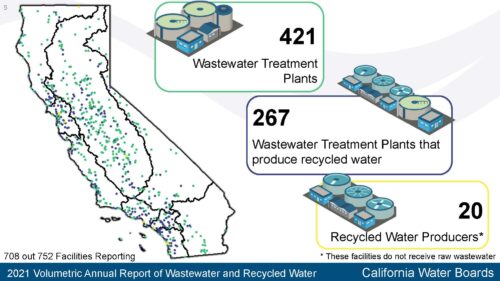 The slide shows the classification of the 708 out of 752 facilities reporting for 2021. There are 421 wastewater treatment facilities shown in green, 267 wastewater treatment facilities that can produce Title 22 recycled water shown in black, and 20 recycled water producers shown in yellow, which do not receive raw influent wastewater but rather treat an already treated effluent from another facility.
The slide shows the classification of the 708 out of 752 facilities reporting for 2021. There are 421 wastewater treatment facilities shown in green, 267 wastewater treatment facilities that can produce Title 22 recycled water shown in black, and 20 recycled water producers shown in yellow, which do not receive raw influent wastewater but rather treat an already treated effluent from another facility.
Summary of data for all reporting years
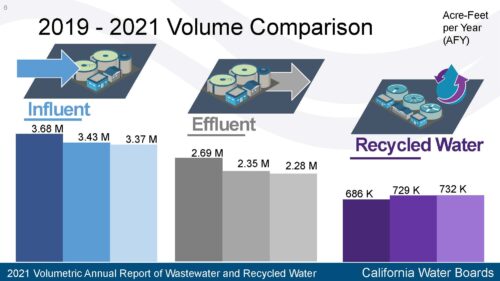
The slide shows the volume comparison for the three years that the data has been collected. The data is categorized as influent, or what’s coming into the plant; effluent, where it is going when discharged; and recycled water. The data is in acre-feet per year unless otherwise noted.
“While we do have three years of data, which is the minimum to be able to provide a trend, it’s really important to note that it’s pretty difficult to draw robust conclusions off of three data points,” said Ms. Greenwood. “So it’s a very good start. … Both the influent and effluent volumes have continued to decrease from 2019 to 2021. And then our recycled water volume has increased slightly.”
The role of conservation in water recycling
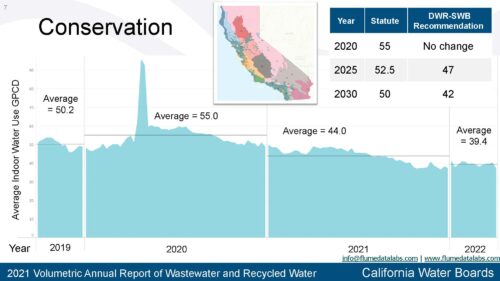 The slide shows data from the Office of Research Planning and Performance for the average indoor residential water use over the last few years. Ms. Greenwood noted that average indoor water use has been decreasing over the past three years, which is consistent and tracks with the decrease in influent coming into wastewater facilities as reported on the Volumetric Annual Report.
The slide shows data from the Office of Research Planning and Performance for the average indoor residential water use over the last few years. Ms. Greenwood noted that average indoor water use has been decreasing over the past three years, which is consistent and tracks with the decrease in influent coming into wastewater facilities as reported on the Volumetric Annual Report.
At the top right is a table presented by the Department of Water Resources and the State Water Board as a joint recommendation for an indoor residential water use standard. Ms. Greenwood noted that the average indoor water use standard is currently lower than the recommendation, and Californians are expected to continue to use water more efficiently and effectively indoors.
“So passive conservation is happening right now, and wastewater collection systems and treatment facilities may continue to experience lower or more concentrated flows due to things like codes and standards and behavioral changes,” she said.
“This isn’t always a bad thing. Water efficiency saves water, energy, and money and protects water quality. And there are a lot of really great benefits for all of this as our climate changes. But it’s really important to note that conservation is critical, but it’s definitely not going to solve California’s water issues all by itself. So this is something that agencies producing recycled water will have to continue to adapt to as the volume of influent entering facilities has a really big impact on how much recycled water can be produced from these facilities.”
Uses of recycled water
The slide at the lower left shows recycled water use by category from 2019 to 2021. Ms. Greenwood pointed out that most categories have remained fairly consistent from 2020 to 2021, with the growth coming mainly from potable uses, such as groundwater recharge and seawater intrusion barriers.
Consistent with prior years, Santa Ana (Region 8) and Los Angeles (Region 4) produce most of the potable recycled water. The Central Valley region (Region 5) remains the largest amount of recycled water used for agriculture irrigation. The Central Coast region (Region 3) and the San Diego region (Region 9) will start to produce potable recycled water soon.
Webpage updates and tools
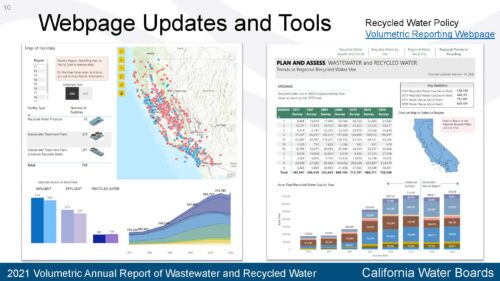 This year in collaboration with the Office of Information Management and Analysis, an interactive tool was developed to display the data on the recycled water webpage. Users can select data by region or specific facility and review submitted summaries of the reported data. The staff’s presentations to the Board are also on the webpage and GeoTracker resources. A new dashboard is in development which will include historical data as well as the volumetric report data in an interactive tool.
This year in collaboration with the Office of Information Management and Analysis, an interactive tool was developed to display the data on the recycled water webpage. Users can select data by region or specific facility and review submitted summaries of the reported data. The staff’s presentations to the Board are also on the webpage and GeoTracker resources. A new dashboard is in development which will include historical data as well as the volumetric report data in an interactive tool.
The volumetric annual report dataset is hosted on the California open data portal. The Pacific Institute used this data for a report that considered how stormwater capture and recycled water use could be increased across the state. WateReuse California has an interactive map tool for displaying the data. The data for 2021 is already posted and available on the California open data portal.
“These data are really helping decision makers and academics with the central question of how can we continue to increase recycled water in California,” said Ms. Greenwood.
Increasing recycled water use
One way recycled water use will increase is when the upcoming regulations for direct potable reuse are adopted. Direct potable reuse is the planned introduction of recycled water either directly into a public water system or into a raw water supply immediately upstream of a water treatment plant.
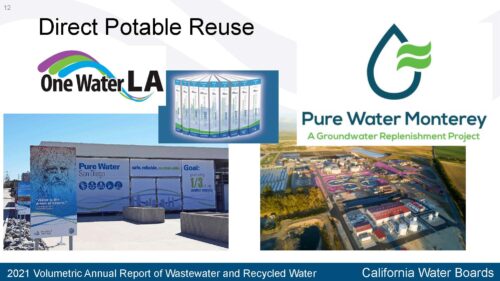 Assembly Bill 574 requires an expert panel to review the proposed Direct Potable Reuse criteria and determine whether the criteria would be protective of public health. The panel is currently reviewing the proposed criteria, and the DPR regulations should be considered for adoption by the State Water Board by December 31, 2023. According to WateReuse California, tens of thousands of acre-feet of direct potable reuse projects are coming in the future.
Assembly Bill 574 requires an expert panel to review the proposed Direct Potable Reuse criteria and determine whether the criteria would be protective of public health. The panel is currently reviewing the proposed criteria, and the DPR regulations should be considered for adoption by the State Water Board by December 31, 2023. According to WateReuse California, tens of thousands of acre-feet of direct potable reuse projects are coming in the future.
“This is one path forward, but there’s still much to be done for us to increase recycled water volumes significantly,” said Ms. Greenwood. “Securing a reliable water supply for California requires greater investments in water infrastructure projects. Water infrastructure requires time and investment beyond just building or expanding a treatment plant. And from 2017 to May 2022, the State Water Board’s division of financial assistance has funded $1.8 billion to recycle water projects and anticipates increasing recycled water volumes in categories for agriculture irrigation, landscape irrigation, groundwater recharge, potable reuse, and other various uses by 124,000 acre-feet by 2027.”
“Although many of these projects are currently under construction, some of the projects intended to be completed over the last two years have remained unfinished due to limited or lack of availability for building materials from potential supply chain issues and have requested extensions,” she continued. “So we need to continue to grow and promote not just infrastructure, but all of the components required to make these systems operate successfully. We need to continue to invest and invest for 20 years from now to incorporate the real possibility of decreasing wastewater flows into our decision making and how that affects recycled water in the future, continuing to be more proactive.”
Refinement of recycled water goals needed
Goals are important as they measure progress and drive change, said Ms. Greenwood. However, the current recycled water goals need to be revisited as more practical and achievable goals are needed.
“We need feasible as well as aspirational goals to feel like progress is being made and to drive investments on a larger scale,” she said. “It shouldn’t just focus on a number. Instead, it should reflect the current state of California’s water landscape and take a more holistic approach that acknowledges conservation and decreasing wastewater flows and the state’s increasing aridification due to climate change.”
“Droughts provide a sense of urgency, but we need to continue planning and working steadily towards developing recycled water supplies even when the state isn’t a drought. These numbers show us that California is continuing to develop recycled water or supplies. However, they also show us how far we still need to go to expand the use of recycled water, especially portable recycled water, and enable communities to build sustainable and resilient water supplies.”
DISCUSSION PERIOD
Chair Joaquin Esquivel acknowledged the impacts of the conservation and the need to account for that decline in usage for right-sizing investments in recycled water. He appreciated the staff’s efforts to make the data available, which is fundamental to decision-making throughout the Board, including the Division of Financial Assistance. In addition, other entities have used the data for additional analysis and insight at the local and state levels.
Board member Sean Maguire expressed concern that the Board has lost sight of the environmental benefits discharged flows have through this reporting. “I didn’t see a breakout of that component in the presentation. So I hope that in future reports, we can get a better sense of how some dischargers are, in fact, putting discharged recycled water, Title 22 quality recycled water even, to environmental benefit. And that is something that we should reflect and recognize and actually preserve, to the extent that’s something that is needed in those given watersheds.”
During the public comment period, Sean Bothwell with California Coastkeeper Alliance said he supports developing more accurate and realistic water recycling goals even if that means ratcheting the number down. “I think the key is making sure they’re realistic and attainable, rather than some lofty goal that just isn’t even feasible to reach.”
He pointed out that while we should be encouraging water recycling, particularly for ocean wastewater discharges, it’s important to realize that the associated brine discharges will decrease and become more concentrated, exacerbating ocean acidification hotspots along the California coast. He suggested it’s time for the Board to start on an ocean acidification policy, and while that is being developed, the Board should consider incentives to encourage dischargers to address the avoidance of ocean acidification hotspots. Perhaps the Division of Financial Assistance could consider ways to incentivize applicants to start planning for potential denitrification of their wastewater discharges.
Jennifer West with WateReuse California appreciated the comments about environmental uses and agreed the Board should look at the number. “Last year, we had almost 225 acre-feet of recycled water used for instream flow natural systems. That combined with our Title 22, we were close to over 1 million acre-feet total. So as we update that policy and look at a new number, we should find a way to recognize the benefit of environmental recycled water.”
Jared Voskuhl, California Association of Sanitation Agencies, noted that in 2021, there was 70,000 acre-feet less effluent, yet recycled use increased by 3000 acre-feet, which is notable.
He also noted that the slide showing conservation data is based on data from Flume, which has meters in a small number of homes. “I don’t think that is representative, and I also don’t want the impression that slide gave in terms of where people are on conservation projected out statewide. I think there are issues with the number of homes that actually have that meter on there in terms of sample size and the sampling bias for the homes that have it on there. Also, there might be regional trends with water conservation that would get you to those numbers. And so ultimately, those projections of 39 GPCD may not be right for statewide numbers.”
Regarding the lower flows of influent, Mr. Voskuhl said, “We’ve heard from members who have said, if flows keep declining, the projects they are planning right now won’t pencil out, or they’re going to have to scale them down, which is notable. And we need to be mindful of perhaps what the sociologist Robert Merton would call the latent function of policies that the state pursues. So with regards to conservation, if we decrease how much households use, there’s going to be a follow-along effect. And there’s going to be adverse impacts to those recycling projects, but also to the collection systems, the infrastructure, and the treatment facilities and what they’re going to have to do to increase treatment of stronger influent.”


